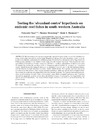Identificador persistente para citar o vincular este elemento:
https://accedacris.ulpgc.es/handle/10553/49605
| Campo DC | Valor | idioma |
|---|---|---|
| dc.contributor.author | Tuya, Fernando | en_US |
| dc.contributor.author | Wernberg, Thomas | en_US |
| dc.contributor.author | Thomsen, Mads S. | en_US |
| dc.date.accessioned | 2018-11-24T09:16:55Z | - |
| dc.date.available | 2018-11-24T09:16:55Z | - |
| dc.date.issued | 2008 | en_US |
| dc.identifier.issn | 0171-8630 | en_US |
| dc.identifier.uri | https://accedacris.ulpgc.es/handle/10553/49605 | - |
| dc.description.abstract | The abundance of a species is generally expected to peak at the centre of its distribution range and decline towards the range limits. Empirical evidence for such ‘abundant centre’ patterns is, however, limited, particularly for subtidal species. We tested the ‘abundant centre’ hypothesis for 8 fish species endemic to the shallow rocky reefs of south-western Australia. Fish abundances were quantified at 6 locations (18 reefs) across ca. 1700 km of coastline, and patterns of distribution were determined by testing the goodness of fit of 3 biogeographical models: (1) ‘normal’ (i.e. ‘abundant centre’ distributions), (2) ‘ramped’ (increase in abundance towards one of the distributional limits), and (3) ‘skewed normal’ (skewed ‘abundant centre’ distributions). Two species had their maximum abundances at the centre of their ranges (‘normal’ patterns), while one species had its highest abundance near its south-eastern range limit (‘skewed normal’ pattern). Two species increased progressively in abundances towards their south-eastern range limits (‘ramped’ patterns), and 3 species showed no apparent patterns across their distribution ranges. Consequently, the expectation that species are most abundant at the centre of their ranges was not supported as a general model by the present study. | en_US |
| dc.language | eng | en_US |
| dc.publisher | 0171-8630 | |
| dc.relation.ispartof | Marine Ecology - Progress Series | en_US |
| dc.source | Marine Ecology Progress Series [ISSN 0171-8630], v. 372, p. 225-230 | en_US |
| dc.subject | 250501 Biogeografía | en_US |
| dc.subject | 3105 Peces y fauna silvestre | en_US |
| dc.subject.other | Abundant centre patterns | en_US |
| dc.subject.other | Macroecology | en_US |
| dc.subject.other | Biogeography | en_US |
| dc.subject.other | Species ranges | en_US |
| dc.subject.other | Reef fishes | en_US |
| dc.subject.other | Western Australia | en_US |
| dc.title | Testing the 'abundant centre' hypothesis on endemic reef fishes in south-western Australia | en_US |
| dc.type | info:eu-repo/semantics/Article | es |
| dc.type | Article | es |
| dc.identifier.doi | 10.3354/meps07718 | |
| dc.identifier.scopus | 58249099429 | - |
| dc.identifier.isi | 000262418100021 | |
| dc.contributor.authorscopusid | 6603608107 | - |
| dc.contributor.authorscopusid | 8657683700 | - |
| dc.contributor.authorscopusid | 7201684589 | - |
| dc.description.lastpage | 230 | - |
| dc.description.firstpage | 225 | - |
| dc.relation.volume | 372 | - |
| dc.investigacion | Ciencias | en_US |
| dc.type2 | Artículo | en_US |
| dc.contributor.daisngid | 308553 | |
| dc.contributor.daisngid | 272528 | |
| dc.contributor.daisngid | 461261 | |
| dc.utils.revision | Sí | en_US |
| dc.contributor.wosstandard | WOS:Tuya, F | |
| dc.contributor.wosstandard | WOS:Wernberg, T | |
| dc.contributor.wosstandard | WOS:Thomsen, MS | |
| dc.date.coverdate | Diciembre 2008 | |
| dc.identifier.ulpgc | Sí | es |
| dc.description.jcr | 2,631 | |
| dc.description.jcrq | Q1 | |
| dc.description.scie | SCIE | |
| item.fulltext | Con texto completo | - |
| item.grantfulltext | open | - |
| crisitem.author.dept | GIR ECOAQUA: Biodiversidad y Conservación | - |
| crisitem.author.dept | IU de Investigación en Acuicultura Sostenible y Ec | - |
| crisitem.author.dept | Departamento de Biología | - |
| crisitem.author.orcid | 0000-0001-8316-5887 | - |
| crisitem.author.parentorg | IU de Investigación en Acuicultura Sostenible y Ec | - |
| crisitem.author.fullName | Tuya Cortés, Fernando José | - |
| Colección: | Artículos | |
Citas SCOPUSTM
32
actualizado el 08-jun-2025
Citas de WEB OF SCIENCETM
Citations
33
actualizado el 08-jun-2025
Visitas
108
actualizado el 30-nov-2024
Descargas
106
actualizado el 30-nov-2024
Google ScholarTM
Verifica
Altmetric
Comparte
Exporta metadatos
Los elementos en ULPGC accedaCRIS están protegidos por derechos de autor con todos los derechos reservados, a menos que se indique lo contrario.
